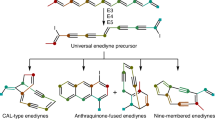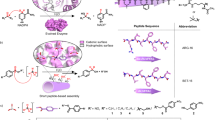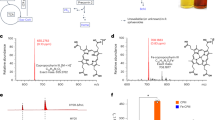Abstract
Many bioactive plant cyclic peptides form side-chain-derived macrocycles. Lyciumins, cyclic plant peptides with tryptophan macrocyclizations, are ribosomal peptides (RiPPs) originating from repetitive core peptide motifs in precursor peptides with plant-specific BURP (BNM2, USP, RD22 and PG1beta) domains, but the biosynthetic mechanism for their formation has remained unknown. Here, we characterize precursor-peptide BURP domains as copper-dependent autocatalytic peptide cyclases and use a combination of tandem mass spectrometry-based metabolomics and plant genomics to systematically discover five BURP-domain-derived plant RiPP classes, with mono- and bicyclic structures formed via tryptophans and tyrosines, from botanical collections. As BURP-domain cyclases are scaffold-generating enzymes in plant specialized metabolism that are physically connected to their substrates in the same polypeptide, we introduce a bioinformatic method to mine plant genomes for precursor-peptide-encoding genes by detection of repetitive substrate domains and known core peptide features. Our study sets the stage for chemical, biosynthetic and biological exploration of plant RiPP natural products from BURP-domain cyclases.

This is a preview of subscription content, access via your institution
Access options
Access Nature and 54 other Nature Portfolio journals
Get Nature+, our best-value online-access subscription
$29.99 / 30 days
cancel any time
Subscribe to this journal
Receive 12 print issues and online access
$259.00 per year
only $21.58 per issue
Buy this article
- Purchase on Springer Link
- Instant access to full article PDF
Prices may be subject to local taxes which are calculated during checkout






Similar content being viewed by others
Data availability
Plant genome sequences were derived from JGI Phytozome (v.13)45 and NCBI GenBank. Known peptide structures were derived from Pubchem62. Gene sequences of peptide precursors have been deposited in GenBank (CcaBURP1, MW570736; CcaBURP2, MW570737; AhyBURP, MW570734 and SkrBURP, MW570735). Transcriptomic data of S. kraussiana has been deposited in the NCBI-SRA (SRR11647978). Metabolomic datasets and reference peptide MS/MS spectra have been submitted to GNPS-MassIVE29 under the accession number MSV000087872. MS/MS spectra of characterized peptides have been submitted to GNPS-MS/MS Spectral Libraries. The molecular network can be found under https://gnps.ucsd.edu/ProteoSAFe/status.jsp?task=c530b123d3984aa58247d6bd2789c69f#. Plant genome analysis outputs by plantiSMASH-RepeatFinder are available at: https://doi.org/10.5281/zenodo.4687169. All other data supporting the findings of this study are presented in the published article including its supporting information or are available from the corresponding authors upon reasonable request.
Code availability
Updated plantiSMASH and RepeatFinder code are available on Github (https://github.com/plantismash/plantismash).
References
Tan, N. H. & Zhou, J. Plant cyclopeptides. Chem. Rev. 106, 840–895 (2006).
de Veer, S. J., Kan, M.-W. & Craik, D. J. Cyclotides: from structure to function. Chem. Rev. 119, 12375–12421 (2019).
Arnison, P. G. et al. Ribosomally synthesized and post-translationally modified peptide natural products: overview and recommendations for a universal nomenclature. Nat. Prod. Rep. 30, 108–160 (2013).
Jennings, C., West, J., Waine, C., Craik, D. & Anderson, M. Biosynthesis and insecticidal properties of plant cyclotides: the cyclic knotted proteins from Oldenlandia affinis. Proc. Natl Acad. Sci. USA 98, 10614–10619 (2001).
Mylne, J. S. et al. Albumins and their processing machinery are hijacked for cyclic peptides in sunflower. Nat. Chem. Biol. 7, 257–259 (2011).
Nguyen, G. K. T. et al. Butelase 1 is an Asx-specific ligase enabling peptide macrocyclization and synthesis. Nat. Chem. Biol. 10, 732–738 (2014).
Harris, K. S. et al. Efficient backbone cyclization of linear peptides by a recombinant asparaginyl endopeptidase. Nat. Commun. 6, 10199 (2015).
Chekan, J. R., Estrada, P., Covello, P. S. & Nair, S. K. Characterization of the macrocyclase involved in the biosynthesis of RiPP cyclic peptides in plants. Proc. Natl Acad. Sci. USA 114, 6551–6556 (2017).
Barber, C. J. S. et al. The two-step biosynthesis of cyclic peptides from linear precursors in a member of the plant family Caryophyllaceae involves cyclization by a serine protease-like enzyme. J. Biol. Chem. 288, 12500–12510 (2013).
Hattori, J., Boutilier, K. A., Campagne, M. M. L. & Miki, B. L. A conserved BURP domain defines a novel group of plant proteins with unusual primary structures. Mol. Gen. Genet. MGG 259, 424–428 (1998).
Kersten, R. D. & Weng, J. K. Gene-guided discovery and engineering of branched cyclic peptides in plants. Proc. Natl Acad. Sci. USA 115, E10961–E10969 (2018).
Treacy, B. K. et al. Bnm1, a brassica pollen-specific gene. Plant Mol. Biol. 34, 603–611 (1997).
Bassüner, R. et al. Abundant embryonic mRNA in field bean (Vicia faba L.) codes for a new class of seed proteins: cDNA cloning and characterization of the primary translation product. Plant Mol. Biol. 11, 321–334 (1988).
Yamaguchi-Shinozaki, K. & Shinozaki, K. The plant hormone abscisic acid mediates the drought-induced expression but not the seed-specific expression of Rd22, a gene responsive to dehydration stress in Arabidopsis thaliana. Mol Gen. Genet. MGG 238, 17–25 (1993).
Zheng, L., Heupel, R. C. & DellaPenna, D. The beta subunit of tomato fruit polygalacturonase isoenzyme 1: isolation, characterization, and identification of unique structural features. Plant Cell 4, 1147–1156 (1992).
Schramma, K. R., Bushin, L. B. & Seyedsayamdost, M. R. Structure and biosynthesis of a macrocyclic peptide containing an unprecedented lysine-to-tryptophan crosslink. Nat. Chem. 7, 431–437 (2015).
Imai, Y. et al. A new antibiotic selectively kills Gram-negative pathogens. Nature 576, 459–464 (2019).
Nagano, N. et al. Class of cyclic ribosomal peptide synthetic genes in filamentous fungi. Fungal Genet. Biol. 86, 58–70 (2016).
Koiso, Y. et al. Ustiloxin: a phytotoxin and a mycotoxin from false smuth balls on rice panicles. Tetrahedron Lett. 33, 4157–4160 (1992).
Culvenor, C. C. J. et al. Structure elucidation and absolute configuration of phomopsin a, a hexapeptide mycotoxin produced by phomopsis leptostromiformis. Tetrahedron 45, 2351–2372 (1989).
Ding, W. et al. Biosynthetic investigation of phomopsins reveals a widespread pathway for ribosomal natural products in Ascomycetes. Proc. Natl Acad. Sci. USA 113, 3521–3526 (2016).
Nguyen, T. Q. N. et al. Post-translational formation of strained cyclophanes in bacteria. Nat. Chem. https://doi.org/10.1038/s41557-020-0519-z (2020).
Nicholas, A. et al. Total synthesis and stereochemical assignment of streptide. J. Am. Chem. Soc. 141, 17361–17369 (2019).
Shabani, S., White, J. M. & Hutton, C. A. Total synthesis of the putative structure of asperipin-2a and stereochemical reassignment. Organ. Lett. 22, 7730–7734 (2020).
Ye, Y. et al. Heterologous production of asperipin-2a: proposal for sequential oxidative macrocyclization by a fungi-specific DUF3328 oxidase. Org. Biomol. Chem. 17, 39–43 (2019).
Crüsemann, M. et al. Heterologous expression, biosynthetic studies, and ecological function of the selective Gq‐signaling inhibitor FR900359. Angew. Chemie Int. Ed. 57, 836–840 (2018).
Horai, H. et al. MassBank: a public repository for sharing mass spectral data for life sciences. J. Mass Spectrom. 45, 703–714 (2010).
Smith, C. A. et al. METLIN: a metabolite mass spectral database. Ther. Drug Monit. 27, 747–751 (2005).
Wang, M. et al. Sharing and community curation of mass spectrometry data with Global Natural Products Social Molecular Networking. Nat. Biotechnol. 34, 828–837 (2016).
Kind, T. et al. Identification of small molecules using accurate mass MS/MS search. Mass Spectrom. Rev. 37, 513–532 (2018).
Behsaz, B. et al. De novo peptide sequencing reveals many cyclopeptides in the human gut and other environments. Cell Syst. 10, 99–108.e5 (2020).
Ng, J. et al. Dereplication and de novo sequencing of nonribosomal peptides. Nat. Methods 6, 596–599 (2009).
Dührkop, K. et al. SIRIUS 4: a rapid tool for turning tandem mass spectra into metabolite structure information. Nat. Methods 16, 299–302 (2019).
Dührkop, K. et al. Systematic classification of unknown metabolites using high-resolution fragmentation mass spectra. Nat. Biotechnol. 9, 462–471 (2020).
Falick, A. M., Hines, W. M., Medzihradszky, K. F., Baldwin, M. A. & Gibson, B. W. Low-mass ions produced from peptides by high-energy collision-induced dissociation in tandem mass spectrometry. J. Am. Soc. Mass. Spectrom. 4, 882–893 (1993).
Phillipson, J. D. Chemical investigations of herbarium material for alkaloids. Phytochemistry 21, 2441–2456 (1982).
Nguyen, G. K. T. et al. Discovery and characterization of novel cyclotides originated from chimeric precursors consisting of albumin-1 chain a and cyclotide domains in the fabaceae family. J. Biol. Chem. 286, 24275–24287 (2011).
Sugawara, F. et al. Insecticidal peptide from mungbean: a resistant factor against infestation with azuki bean weevil. J. Agric. Food Chem. 44, 3360–3364 (1996).
Griesmann, M. et al. Phylogenomics reveals multiple losses of nitrogen-fixing root nodule symbiosis. Science 361, eaat1743 (2018).
Zhuang, W. et al. The genome of cultivated peanut provides insight into legume karyotypes, polyploid evolution and crop domestication. Nat. Genet. 51, 865–876 (2019).
Sainsbury, F., Thuenemann, E. C. & Lomonossoff, G. P. pEAQ: versatile expression vectors for easy and quick transient expression of heterologous proteins in plants. Plant Biotechnol. J. 7, 682–693 (2009).
Boersema, P. J., Raijmakers, R., Lemeer, S., Mohammed, S. & Heck, A. J. R. Multiplex peptide stable isotope dimethyl labeling for quantitative proteomics. Nat. Protoc. 4, 484–494 (2009).
Tang, Y. et al. Expression of a vacuole-localized BURP-domain protein from soybean (SALI3-2) enhances tolerance to cadmium and copper stresses. PLoS ONE 9, e107337 (2014).
Ragland, M. & Soliman, K. M. A molecular approach to understanding aluminum tolerance in soybean (Glycine max L.). Global Environmental Biotechnology (ed. Wise, D. L.) Vol. 114, 125–138 (Springer, 1997).
Goodstein, D. M. et al. Phytozome: a comparative platform for green plant genomics. Nucleic Acids Res. 40, D1178–D1186 (2012).
Kautsar, S. A., Suarez Duran, H. G., Blin, K., Osbourn, A. & Medema, M. H. PlantiSMASH: automated identification, annotation and expression analysis of plant biosynthetic gene clusters. Nucleic Acids Res. 45, W55–W63 (2017).
Schmutz, J. et al. Genome sequence of the palaeopolyploid soybean. Nature 463, 178–183 (2010).
Medema, M. H. & Osbourn, A. Computational genomic identification and functional reconstitution of plant natural product biosynthetic pathways. Nat. Prod. Rep. 33, 951–962 (2016).
van der Velden, N. S. et al. Autocatalytic backbone N-methylation in a family of ribosomal peptide natural products. Nat. Chem. Biol. 13, 833–835 (2017).
Broderick, J. B., Duffus, B. R., Duschene, K. S. & Shepard, E. M. Radical S-adenosylmethionine enzymes. Chem. Rev. 114, 4229–4317 (2014).
Xu, H. et al. Genome-scale identification of Soybean BURP domain-containing genes and their expression under stress treatments. BMC Plant Biol. 10, 197 (2010).
Kressner, D., Chambers, M., Burke, R., Agus, D. & Mallick, P. ProteoWizard: open source software for rapid proteomics tools development.Bioinformatics 24, 2534–2536 (2008).
Shannon, P. Cytoscape: A Software environment for integrated models of biomolecular interaction networks. Genome Res. 13, 2498–2504 (2003).
Bankevich, A. et al. SPAdes: a new genome assembly algorithm and its applications to single-cell sequencing. J. Comput. Biol. 19, 455–477 (2012).
Altschul, S. Gapped BLAST and PSI-BLAST: a new generation of protein database search programs. Nucleic Acids Res. 25, 3389–3402 (1997).
Priyam, A. et al. Sequenceserver: a modern graphical user interface for custom BLAST databases. Mol. Biol. Evol. 36, 2922–2924 (2019).
Gibson, D. G. et al. Enzymatic assembly of DNA molecules up to several hundred kilobases. Nat. Methods 6, 343–345 (2009).
Madeira, F. et al. The EMBL-EBI search and sequence analysis tools APIs in 2019. Nucleic Acids Res. 47, W636–W641 (2019).
Frisch, M. J. et al. Gaussian 16 (Gaussian.com, 2016).
Frederick, R. O. et al. Small-scale, semi-automated purification of eukaryotic proteins for structure determination. J. Struct. Funct. Genomics 8, 153–166 (2007).
Henikoff, S. & Henikoff, J. G. Amino acid substitution matrices from protein blocks. Proc. Natl Acad. Sci. USA 89, 10915–10919 (1992).
Kim, S. et al. PubChem substance and compound databases. Nucleic Acids Res. 44, D1202–D1213 (2016).
Acknowledgements
We thank D. Michener and M. Palmer for access to the Matthaei Botanical Garden and C. Dick and B. Ruhfel for access to the University of Michigan Herbarium. We also thank G. Lomonosoff (John Innes Centre, UK) for sharing the pEAQ-HT vector. This work was supported by the Biological Sciences Scholar Program at the University of Michigan (R.D.K) and the Graduate School for Experimental Plant Sciences in the Netherlands (M.H.M.).
Author information
Authors and Affiliations
Contributions
D.N.C., L.S.M. and F.d.W. contributed equally to this work. R.D.K. and M.H.M. conceived the idea. D.N.C., W.L., K.S. and R.D.K. collected plant samples, prepared and analyzed plant extracts by metabolomics, isolated and structurally elucidated plant peptides. R.D.K. expressed plant proteins in tobacco, prepared and analyzed transgenic tobacco leaf extracts by metabolomics. L.S.M. and R.D.K. expressed proteins in E. coli, purified proteins, performed and analyzed in vitro enzyme assays by bottom-up proteomics. T.M. analyzed known plant cyclic peptide structures. K.S., J.W.W., O.G.M., A.T. and J.Z.S. performed peptide bioactivity assays. M.H.M., S.K. and F.d.W. designed and wrote RepeatFinder code and integrated RepeatFinder into plantiSMASH. M.H.M., S.K., F.d.W. and R.D.K. analyzed plant genomes via plantiSMASH-RepeatFinder. R.D.K., M.H.M., D.N.C., L.S.M. and F.d.W. wrote the paper.
Corresponding authors
Ethics declarations
Competing interests
The authors declare no competing interests.
Additional information
Peer review information Nature Chemical Biology thanks Yit-Heng Chooi and the other, anonymous, reviewer(s) for their contribution to the peer review of this work.
Publisher’s note Springer Nature remains neutral with regard to jurisdictional claims in published maps and institutional affiliations.
Extended data
Extended Data Fig. 1 Peptides with side-chain-macrocyclizations from plants, bacteria and fungi.
Representative chemical structures are shown. Macrocyclic bonds are highlighted in red.
Extended Data Fig. 2 Extraction analysis of reference plant peptides with side-chain-macrocyclic bonds from source plant material.
Reference peptides were monitored in extract fractions based on corresponding extracted ion chromatogram (EIC) peak areas. EIC peak area data were plotted as dot plots overlayed with bar graphs representing the mean of three extractions of tissue from three biologically different plants (N = 3). Error bars of the bar graph represent one standard deviation (±SD). Abbreviation: EA - ethyl acetate, nBuOH - n-butanol, A. hypochondriacus – Amaranthus hypochondriacus, S. floribunda – Stephanotis floribunda, C. argentea – Celosia argentea, R. cordifolia – Rubia cordifolia, C. americanus.
Extended Data Fig. 3 Molecular network of peptide-filtered LC-MS/MS datasets of UM botanical collections.
Full molecular network of peptide-filtered datasets with characterized spectral clusters highlighted including new cyclic plant peptides.
Extended Data Fig. 4 Cyclopeptide alkaloid-containing spectral cluster of peptide-filtered LC-MS/MS datasets of UM botanical collections.
Nodes are colored according to source plant as shown in the top box. Node sizes represent relative precursor ion intensity. Node values are precursor ion mass values. Pie charts represent relative spectral counts of defined groups. Nodes of reference peptides and characterized peptides are indicated with arrows.
Extended Data Fig. 5 Candidate BURP domain precursor peptides of target cyclic plant peptides from botanical collections.
BURP domains are underlined, putative core peptides are highlighted in red.
Extended Data Fig. 6 Bioactivity evaluation of side-chain-macrocyclic plant peptides.
(a) Antibacterial assays show no significant growth inhibition of Bacillus subtilis 168, Staphylococcus aureus ATCC43300 or Shigella flexneri BS103 at 100 μM compound concentration compared to 1% DMSO control after 24 h incubation at 37 °C compared to antibiotic positive controls of ciprofloxacin and rifampicin. Data represents mean of OD600 of cultures (N = 2) ± SEM. (b) Compounds were assessed for anti-cancer activity at a concentration of 100 µg/mL in four different human cell lines including H1437 (lung adenocarcinoma), Caco-2 (colorectal adenocarcinoma), LNCaP (prostate adenocarcinoma), and Huh7 (hepatocellular carcinoma). Data represents the mean ± SEM of N = 68 vehicle controls and N = 3 treatments. Statistically significant reductions in cell viability were determined using unpaired two-tailed t-tests in Graphpad Prism 9 (p < 0.0001 = ****, p < 0.001 = ***, p < 0.01 = **). (c) Sequences of BURP domain protein homologs of selanine precursor peptide SkrBURP. SkrBURP homologs from bruchid-resistant Vigna radiata contain core peptides which match the insecticidal cyclopeptide alkaloid vignatic acid A from bruchid-resistant Vigna radiata strain TC1966.
Extended Data Fig. 7 In vitro reconstitution of SkrBURP and CcaBURP domains.
(a) Detection of monocyclic core peptide modifications in purified MBP-CcaBURP2-[1xQLLVW] after incubation with Cu(II) at pH 7. (b) Detection of monocyclic core peptide modification in purified CcaBURP1-[1xQILFW] after incubation with Cu(II) at pH 7. (c) Detection of desmethyl-selanine A and B after incubation of tryptic bicyclic core peptide iii of SkrBURP-[1xVLFYPSY] with aminopeptidase (AP) and carboxypeptidase (CP). Asterisks (*) notes a cyclic peptide with a different MS/MS spectrum than desmethyl-selanine B. (d) Detection of cercic acid after incubation of tryptic monocyclic core peptide ii of CcaBURP1-[1xQILFW] with aminopeptidase and carboxypeptidase. BURP-domain-sequences are underlined, core peptides are highlighted in red, bold sequences are characterized tryptic peptides including core peptides. Abbreviation: MBP - maltose-binding protein.
Extended Data Fig. 8 Biosynthetic proposal for BURP-domain-derived plant RiPPs legumenin, lyciumin and stephanotic acid-[LV].
Biosynthesis of BURP-domain-derived plant RiPPs is proposed to proceed through BURP domain cyclization of core peptide motifs, N-terminal proteolysis, N-terminal protection and C-terminal proteolysis. Legumenin biosynthesis involves two sequential cyclizations, in which the C-terminal macrocycle is being formed first. Formed macrocyclic bonds in core peptide motifs are highlighted in red.
Extended Data Fig. 9 Biosynthetic proposal for BURP-domain-derived plant RiPPs selanine A (bicyclopeptide alkaloid), selanine B (cyclopeptide alkaloid) and cercic acid.
Biosynthesis of BURP-domain-derived plant RiPPs is proposed to proceed through BURP domain cyclization of core peptide motifs, N-terminal proteolysis, N-terminal protection and C-terminal proteolysis. Selanine A biosynthesis involves two sequential cyclizations, in which the N-terminal macrocycle is formed first. Formed macrocyclic bonds in core peptide motifs are highlighted in red.
Supplementary information
Supplementary Information
Supplementary Tables 1–11, Figs. 1–13 and Notes 1–11.
Supplementary Data 1
Side-chain-macrocyclic peptide analysis.
Supplementary Data 2
Source plants of metabolomic datasets.
Supplementary Data 3
Molecular cluster analysis with reference peptide spectra from Extended Data Fig. 3.
Supplementary Data 4
plantiSMASH-RepeatFinder genome analysis.
Rights and permissions
About this article
Cite this article
Chigumba, D.N., Mydy, L.S., de Waal, F. et al. Discovery and biosynthesis of cyclic plant peptides via autocatalytic cyclases. Nat Chem Biol 18, 18–28 (2022). https://doi.org/10.1038/s41589-021-00892-6
Received:
Accepted:
Published:
Issue Date:
DOI: https://doi.org/10.1038/s41589-021-00892-6
This article is cited by
-
An intramolecular macrocyclase in plant ribosomal peptide biosynthesis
Nature Chemical Biology (2024)
-
Ripping and stitching with copper
Nature Chemical Biology (2024)
-
Recent advances in the biosynthesis of ribosomally synthesized and posttranslationally modified peptides of fungal origin
The Journal of Antibiotics (2023)
-
Discovery and biosynthesis of tricyclic copper-binding ribosomal peptides containing histidine-to-butyrine crosslinks
Nature Communications (2023)
-
HypoRiPPAtlas as an Atlas of hypothetical natural products for mass spectrometry database search
Nature Communications (2023)



